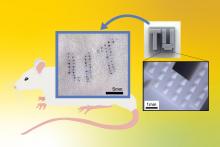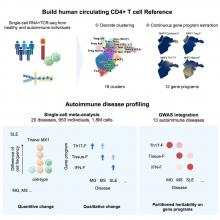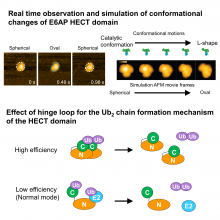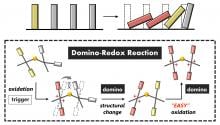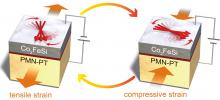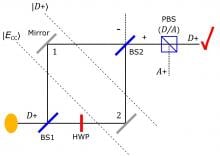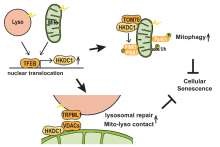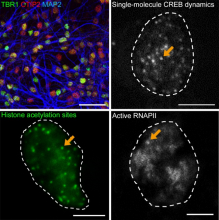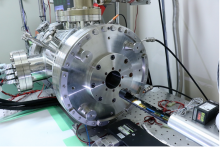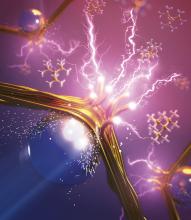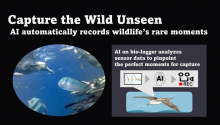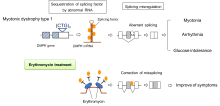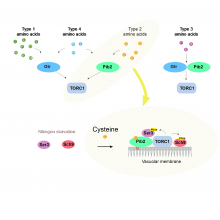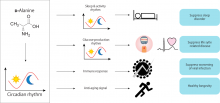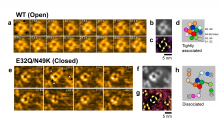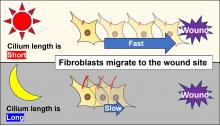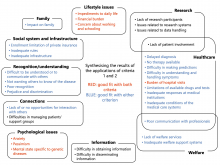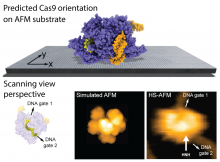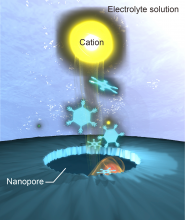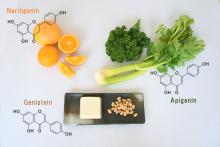Japan
News
11 Jan 2024
Researchers from Osaka University found that CD4+ T cells can be classified into 18 categories and 12 distinct gene programs, and that characteristic changes in CD4+ T cell profiles are associated with autoimmune disease, sex, and aging. Analysis of these distinctive immune cell profiles could be used to predict autoimmune disease in the future, paving the way for precision medicine.
11 Jan 2024
Researchers at Nano Life Science Institute (WPI-NanoLSI), Kanazawa University report in Nano Letters how the flexibility of a protein hinge plays a crucial role in the transfer of proteins in key cell processes.
11 Jan 2024
Researchers from SANKEN (The Institute of Scientific and Industrial Research), at Osaka University, Shizuoka Institute of Science & Technology, and collaborating partners have resolved a problem that has limited the environmental sustainability of peracid synthesis. By judicious choice of the solvent and light input, approximately room-temperature autoxidation of aldehydes proceeds in a manner that results in industrially useful peracids or carboxylic acids. This work is an important advance in green chemistry that will help minimize the carbon footprint of the chemical industry.
09 Jan 2024
Transmitting an effect known as a domino reaction using redox chemistry has been achieved for the first time.
09 Jan 2024
A research team from Osaka University, The University of Tokyo, and Tokyo Institute of Technology revealed the microscopic origin of the large magnetoelectric effect in interfacial multiferroics composed of the ferromagnetic Co2FeSi Heusler alloy and the piezoelectric material. They observed element-specific changes in the orbital magnetic moments in the interfacial multiferroic material using an X-ray Magnetic Circular Dichroism (XMCD) measurement under the application of an electric field, and they showed the change contributes to the large magnetoelectric effect. The findings provide guidelines for designing materials with a large magnetoelectric effect, and it will be useful in developing new information writing technology that consumes less power in spintronic memory devices. The research results will be shown in an article, “Strain-induced specific orbital control in a Heusler alloy-based interfacial multiferroics” published in NPG Asia Materials.
09 Jan 2024
Researchers from Osaka University and collaborating partners have, via reductive amination, resolved a problem that has limited the applicability of carboxylic acids to alkylamine production. Their experimental protocol is environmentally sustainable, simple and convenient to conduct, and works for a broad range of starting materials. This work is an important advance in green chemistry that might help minimize the environmental footprint of synthesizing a class of molecule that's used to manufacture many everyday products.
05 Jan 2024
What actually happens is much weirder, and may help us understand more about quantum mechanics
01 Jan 2024
Researchers from Osaka University have shown that a protein called HKDC1 is a new target of another protein, TFEB, and plays key roles in maintaining the stability of both mitochondria and lysosomes. HKDC1 is essential for mitophagy to remove damaged mitochondria, and mediates mitochondria–lysosome contact, which is critical for lysosomal repair. The role of HKDC1 in maintaining the stability of these organelles counteracts cellular senescence, revealing HKDC1 as a potential therapeutic target for age-related diseases.
26 Dec 2023
Researchers from Osaka University and Shenzhen Bay Laboratory found that neuronal activity induces gene expression at sites of acetylation by promoting the emergence of cAMP response element binding protein (CREB), CREB binding protein (CBP), and RNA polymerase II. These proteins are targeted to the appropriate sites by CBP-mediated histone acetylation at activity-dependent gene loci.
25 Dec 2023
Kavli IPMU researchers are part of a team that has shown it is possible to image small animal tissue clearly to several hundred micrometers using multi-probe imaging.
25 Dec 2023
Researchers employ common plastics to kickstart radical chain reactions, creating a way to reuse plastic waste while improving process safety and efficiency.
22 Dec 2023
Researchers from Osaka Metropolitan University assessed the correlation between human mobility restrictions and the medical costs associated with lifestyle-related diseases during the COVID-19 pandemic in Japan. A cross-sectional study revealed that an increase in walking and public transit use was associated with reduced medical costs of lifestyle diseases. These findings implicate governments to take measures other than restricting walking and public transit during pandemics and emphasize the importance of walkable cities.
22 Dec 2023
Researchers from Osaka University developed a bio-logger for seabirds that enables long-term observation of rare behaviors. The bio-logger employs low-power depth sensors and accelerometers to identify rare behavior using a light-weight outlier detection model and records the behavior in a 5-min video. Observations using the bio-loggers on Streaked Shearwaters revealed novel aspects of head-shaking and foraging strategies. This approach will enable a wider range of animal behaviors in various environments to be observed.
21 Dec 2023
Kavi IPMU researchers have analyzed more than one million galaxies to explore primordial fluctuations that seeded the formation of the structure of the entire universe.
21 Dec 2023
A research group led by Osaka University and University of Hawaii Manoa found that in female fruit flies, microorganisms enhance reproductive function, boosting the number of cells that form eggs and the number of mature eggs. This is done by controlling the release of hormones to speed up cell division in the ovaries, and limiting programmed cell death. These findings could improve reproductive medicine and could aid the development of new methods to enhance fertility.
21 Dec 2023
A team of researchers has developed an innovative method to design complicated all-α proteins, characterized by their non-uniformly arranged α-helices as seen in hemoglobin. Employing their novel approach, the team successfully created five unique all-α protein structures, each distinguished by their complicated arrangements of α-helices. This capability holds immense potential in designing functional proteins.
21 Dec 2023
In a phase 2 trial, researchers from Osaka University have found that erythromycin, a commonly used antibiotic, has acceptable safety and tolerability profiles in patients with myotonic dystrophy type 1. This common form of muscular dystrophy currently has no cure, and the research team is hopeful that phase 2b and 3 trials will further reveal the efficacy of erythromycin as a treatment—at least in some patients.
21 Dec 2023
Researchers from Osaka University have discovered how amino acids activate a key cell, TORC1, which is a master regulator in living organisms that controls whether cells grow or recycle their contents in yeast. Notably, the team found that the amino acid cysteine is sensed by a protein called Pib2 and that the two bind together to trigger TORC1. This is important because faulty TORC1 has been linked to disease such as cancer.
21 Dec 2023
Researchers from Osaka University have shown that the rare D-form of the amino acid alanine shows a clear circadian rhythm, and is able to affect the circadian clock and regulate gluconeogenesis, a method of glucose release, in the kidney. D-alanine upregulates genes linked to both gluconeogenesis and the circadian rhythm through the circadian transcriptional network. D-alanine is linked to many metabolic and immunological diseases, and this mechanistic insight could potentially lead to novel therapeutic approaches.
20 Dec 2023
Researchers at Nano Life Science Institute (WPI-NanoLSI), Kanazawa University report in Nature Communications a high-speed atomic force microscopy study of the structural dynamics of sodium ion channels in cell membranes. The findings provide insights into the mechanism behind the generation of cell-membrane action potentials.
20 Dec 2023
We’re all familiar with our body’s internal clock: it gives us cues on when to wake and when to rest, but it also can determine the rate and time of day at which your body most effectively heals wounds.
13 Dec 2023
A previously mysterious small RNA molecule in mice is found to play a crucial role in gene expression, and may be the first identified member of a new class of regulatory RNAs.
13 Dec 2023
Scientists at Osaka Metropolitan University have developed an efficient, non-invasive, and pain-free method to generate canine-induced pluripotent stem cells (iPSCs). They identified six reprogramming genes that can boost canine iPSC generation by 120 times compared to conventional methods using fibroblasts. The iPSCs were created from urine-derived cells without the need for feeder cells, an impossible feat until now. Their findings are expected to advance regenerative medicine and genetic disease research in veterinary medicine.
12 Dec 2023
Researchers from Osaka University created an online space for conversation, collaboration and knowledge sharing among patients with rare diseases, their families, researchers and policymakers. A series of workshops generated evidence that could contribute to new policies in the field of rare diseases and explore ways that stakeholders could be involved in the process.
12 Dec 2023
Researchers from Osaka University and collaborating partners have developed a new means of manipulating Mie scattering from nanostructures. By judicious choice of the laser illumination position with respect to the center of a nanostructure, one can strongly enhance optical responses that would not have been otherwise possible. This work is an important milestone in modern meta-photonics and will benefit computing and communication technologies.
08 Dec 2023
Researchers at Kanazawa University report in Frontiers in Molecular Biosciences a computational method to predict the placement of proteins on AFM substrates based on electrostatic interactions.
08 Dec 2023
Researchers from Osaka University investigated the thermal energy changes across nanopores that allow the selective flow of ions. Switching off the flow of ions in one direction led to a cooling effect. The findings have applications in nanofluidic devices and provide insight into the factors governing ion channels in cells. The nanopore material could be tailored to tune the cooling and arrays could be produced to scale up the effect.
07 Dec 2023
A research team led by Osaka Metropolitan University focused on generative AI as an information-gathering tool in the medical field. The results showed that one of the generative AIs suggested mostly fictitious references, while the other suggested multiple references with the same level of accuracy as the researchers. The use of generative AI in literature search suggests the possibility of efficiently collecting a vast amount of medical information, provided that users are well aware that the performance of generative AI is still in its infancy and that not all information presented is necessarily reliable. It is advised to use different generative AIs depending on the type of information needed.
30 Nov 2023
An international team of researchers led by Osaka Metropolitan University has elucidated the process by which the major flavonoids naringenin, apigenin, and genistein are metabolized in the body. These findings are fundamental in elucidating the correlation between the metabolism of flavonoids in the body and their potential health benefits.
Events
17 Nov 2011
The conference will be held on 17th November to 18th November at Tianjin, P.R. China
09 Nov 2011
The conference will be held on 7th November 2011 to 10th November 2011 at International Convention Center (ICC), Jeju, Korea
07 Nov 2011
The conference will be held on 7th November 2011 to 10th November 2011 at DoubleTree Hotel San Jose, San Jose, CA, USA
11 Aug 2011
The conference will be held on 11th August 2011 to 12th August 2011 at Facultad de Ingeniería, Universidad de Buenos Aires, Buenos Aires, Argentina

09 Jun 2011
This year's symposium sets its theme as "Japan and the United States in Changing Asia" and discusses how Japan and the US,
in the context of China's emerging power and increasing debates on Asia integration, act in political financial and business fields and which direction Japan-US relationship should be searching for.
28 Nov 2011
The conference will be held on 28 November to 2 December at Pacifico Yokohama, Kanagawa, Japan.
22 Nov 2011
The conference will be held from 22-25 November at Ishikawa Ongakudo.
30 Oct 2011
The conference will be held on 30 October to 2 November in Sendai, Japan.
28 Sep 2011
The symposium will be held on 28-30 September at Le Meridien, Kota Kinabalu, Malaysia.
28 Aug 2011
The workshop will be held on 28-31 August at Nagaragawa Convention Center, Gifu, Japan.
22 Aug 2011
IFOST 2011 will be held on 22-24 August at Harbin University of Science and Technology, China.
21 Jun 2011
ICPST-28 will take place at Chiba University on the 21-24 June 2011.
30 May 2011
The 9th Japan / Korea International Symposium on Resources Recycling and Materials Science will take place at the Kansai University Centenary Memorial Hall from 30th May to 1st June 2011.
09 Nov 2011
The Japan Chapter of SAMPE is pleased to announce the 12th Japan International SAMPE Symposium and Exhibition (JISSE12) to be held from November 9 (Wed.) to 11 (Fri.) in 2007 at Tokyo Fashion Town Bldg., Tokyo.
19 May 2011
Conference Theme:
“Nanotechnology and Its Impact on Electron Devices”
- Successive Evolution of Electron Devices -
10 Mar 2011
The 4th IC-PLANTS is to be held at the Takayama Public Cultural Hall, Takayama JAPAN.

02 Mar 2011
An exhibition titled “Saneatsu and Red Porcelain” will be held in March and April at the Shigenori Tomioka Collection Gallery which opened in May 2009. This is an exhibition which takes the shape of word-association game-like concept linking Saneatsu Mushakoji to Naoya Shiga to Wanli red porcelain to five-colored Ming Dynasty porcelain.
18 Feb 2011
In the present symposium, cutting-edge nanotechnology R&Ds related to energy, environment, and resources issues are presented.

18 Jan 2011
Toyohashi University of Technology will host an International Symposium on "Quality Assurance and International Standards of Engineering Education" as following schedule.

03 Feb 2011
The first international symposium of the Strategic Exploitation of Neuro-Genetics for Emergence of the Mind program is to be held on 3 February 2011 in Tokyo, Japan.
02 Mar 2011
The MANA International Symposium, jointly held with International Center for Young Scientist (ICYS) is organized once a year to publish the research activities of MANA and ICYS.
17 Jan 2011
NIMS International Symposium on Photocatalysis & Environmental Remediation Materials 2011 will be held between the 17th and the 19th January 2011.

26 Nov 2010
International Cooperation in Engineering Education and its Effects upon Industrial Development - Achievements and Challenges -

24 Nov 2010
An international doctoral course between the RIKEN Yokohama institute Omics Science Center and Karolinska Institutet Department of Cell and Molecular Biology (Sweden) is to be held in November

24 Nov 2010
RIKEN Yokohama institute Omics Science Center and Karolinska Institutet Department of Cell and Molecular Biology (Sweden) are holding a joint international doctoral course on the subject “Functional Architecture of the Cell Nucleus”.

02 Jul 2010
Leading scientists to discuss developmental perspectives in vertebrate evolution

03 Jun 2010
It is our great pleasure to announce that Waseda University Organization for Japan-US Studies is holding the third international symposium “Japan, the United States, and China and Integration of East Asia: Conceptual Issues and Priorities”.

28 May 2010
While confusion deepens on the situation of the security treaties of Japan, the year 2010 brings the 50th year since the conclusion of the revised Japan-U.S. Security Treaty.

17 Mar 2010
Mita Logic Seminar "A Proof Theory Workshop (with Lecture Series by Grigori Mints)" is to be held as follows.
*Admission free, no registration required.
*This event will be held in English; no interpretation provided.
Researchers
Sorry, no researchers coming up for this topic.
Giants in history
Ruby Sakae Hirose (1904 – 1960) was a Japanese-American scientist whose research contributed significantly to our understanding of blood clotting, allergies and cancer.
Haisako Koyama (1916 – 1997) was a Japanese solar observer whose dedication to recording sunspots – cooler parts of the sun’s surface that appear dark – produced a sunspot record of historic importance.
Michiaki Takahashi (17 February 1928 – 16 December 2013) was a Japanese virologist who developed the first chickenpox vaccine.
Toshiko Yuasa (11 December 1909 – 1 February 1980) was the first Japanese female physicist whose research on radioactivity shed light on beta decay – the process in which an atom emits a beta particle (electron) and turns into a different element.
Baron Kitasato Shibasaburo (29 January 1856 – 13 June 1931) was a Japanese physician and bacteriologist whose work led to a new understanding of preventing and treating tetanus, diphtheria and anthrax.
By isolating soil microorganisms and studying the compounds they produce, Satoshi Omura (born 1935) discovered almost 500 organic compounds with unique properties that were produced by these microorganisms, including many new antibiotics.
In 1915, pathologist Katsusaburo Yamagiwa and his research assistant Koichi Ichikawa became the first to prove that chronic exposure to chemicals can cause cancer.
In 1915, Koichi Ichikawa along with pathologist Katsusaburo Yamagiwa became the first to prove that chronic exposure to chemicals can cause cancer.
Reiji Okazaki (8 October 1930 – 1 August 1975) and Tsuneko (7 June 1933) were a Japanese couple who discovered Okazaki fragments – short sequences of DNA that are synthesized during DNA replication and linked together to form a continuous strand.
Tsuneko (7 June 1933) and Reiji Okazaki (8 October 1930 – 1 August 1975) were a Japanese couple who discovered Okazaki fragments – short sequences of DNA that are synthesized during DNA replication and linked together to form a continuous strand.
Husband and wife team, Kimishige (3 December 1925 – 6 July 2018) and Teruko Ishizaka (28 September 1926 – 4 June 2019) discovered the antibody class Immunoglobulin E (IgE) that triggers allergic reactions. They also discovered that IgE antibodies attach to white blood cells, known as mast cells, releasing histamine, which causes allergic reactions.
Husband and wife team, Kimishige (3 December 1925 – 6 July 2018) and Teruko Ishizaka (28 September 1926 – 4 June 2019) discovered the antibody class Immunoglobulin E (IgE) that triggers allergic reactions. They also discovered that IgE antibodies attach to white blood cells, known as mast cells, releasing histamine, which causes allergic reactions.
Japanese chemist Takamine Jokichi (3 November 1854 – 22 July 1922) founded the Tokyo Artificial Fertilizer Company, where he isolated a starch-digesting enzyme (named takadiastase) from the fungus Aspergillus oryzae.
Hideki Yukawa (23 January 1907 – 8 September 1981) was awarded the Nobel Prize in Physics in 1949 for predicting the existence of the pi meson subatomic particle. Japan’s first Nobel laureate, Yakawa also expressed his support for nuclear disarmament by signing the Russell–Einstein Manifesto in 1955.
Shinichiro Tomonaga (31 March 1906 – 8 July 1979), together with Richard Feynman and Julian Schwinger, was awarded the Nobel Prize in Physics in 1965, for their contributions to advance the field of quantum electrodynamics. Tomonaga was also a strong proponent of peace, who actively campaigned against the proliferation of nuclear weapons and promoted the peaceful use of nuclear energy.
Japanese chemist Kenichi Fukui (4 October 1918 – 9 January 1998) was the first Asian scientist to be awarded the Nobel Prize in Chemistry. Together with Roald Hoffman, he received this honour in 1981 for his independent research into the mechanisms of chemical reactions.
Minoru Shirota (April 23, 1899 – March 10, 1982) was a Japanese microbiologist who invented the popular fermented drink Yakult.
Japanese physicist Ukichiro Nakaya (1900-1962) made the world’s first artificial snowflakes. He started his research on snow crystals in the early 1930s at Hokkaido University, where there is an unlimited supply of natural snow in winter. By taking over 3,000 photographs, he established a classification of natural snow crystals and described their relationship with weather conditions.
The techniques that make industrial pearl culturing possible were developed over a century ago at the Misaki Marine Biological Station in Japan. The station’s first director, Professor Kakichi Mitsukuri, emphasized to Kokichi Mikimoto in 1890 that stimulating pearl sac formation was important for pearl growth, and they went on to successfully develop methods for culturing pearls.
The field of solid-state ionics originated in Europe, but Takehiko Takahashi of Nagoya University in Japan was the first to coin the term ‘solid ionics’ in 1967. ‘Solid-state ionics’ first appeared in 1971 in another of his papers, and was likely a play on ‘solid-state electronics’, another rapidly growing field at the time.
Chika Kuroda (24 March 1884 – 8 November 1968) was a Japanese chemist whose research focussed on the structures of natural pigments.
Motoo Kimura (13 November 1924 – 13 November 1994) was a Japanese theoretical population geneticist who is best remembered for developing the neutral theory of molecular evolution.
Osamu Shimomura (27 August 1928 – 19 October 2018) was a Japanese organic chemist and marine biologist who dedicated his career to understanding how organisms emitted light.
Kikunae Ikeda (8 October 1864 – 3 May 1936) was a Japanese chemist who discovered the fifth basic taste, umami.
Umetaro Suzuki (7 April 1874 – 20 September 1943) was a Japanese scientist best remembered for his research on beriberi, a disease caused by vitamin B1 deficiency, characterized by limb stiffness, paralysis and pain.
Kono Yasui (16 February 1880 – 24 March 1971) was a Japanese botanist who researched the genetics of poppies, corn and spiderworts and surveyed the plants that had been affected by the nuclear fallout after the atomic bombings of Hiroshima and Nagasaki.
Hitoshi Kihara (1893 – 1986) was one of the most famous Japanese geneticists of the 20th century. One of his most significant contributions was identifying sex chromosomes (X and Y) in flowering plants.
Michiyo Tsujimura (17 September 1888 – 1 June 1969) was a Japanese agricultural scientist and biochemist recognized for her research of green tea components.
A Japanese surgeon, Tetsuzo Akutsu (20 August 1922 – 9 August 2007) built the first artificial heart capable of keeping an animal alive.
Ogino Ginko (3 March 1851 – 23 June 1913) was the first registered female doctor to practise modern medicine in Japan.
Japanese geochemist Katsuko Saruhashi developed the first method and tools for measuring carbon dioxide in seawater


